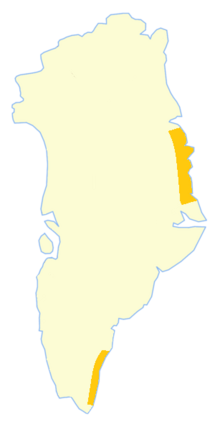Hallvard Ophuus Devold(8 November 1898 – 10 September 1957) was a NorwegianArctic explorer,trapper and meteorologist. He was instrumental in the attempt to establishEric the Red's Landin 1931. His brotherFinn Devold(1902–1977) shared his vision and helped to establish a Norwegian station atFinnsbu,SE Greenland.[1]
Hallvard Devold | |
|---|---|
 | |
| Born | 8 November 1898 Tysfjord,Norway |
| Died | 10 September 1957(aged 58) Karmøy,Norway |
| Nationality | Norwegian |
| Occupation(s) | Polar explorer, trapper, meteorologist |
| Known for | Vision to expand Norwegian sovereignty to East Greenland |


Biography
editHallvard graduated from theUniversity of Osloin 1920. He worked as a meteorological assistant at the Haldde Observatory inAltauntil 1922. He went for the first time to the Arctic in the summer of 1922 as a coal mining technician inSvalbard.
On the following winter he took a radio telegraphy course, and in the spring of 1923 he was hired as a meteorology assistant and radio telegraphist at theKvadehukenstation inBrøggerhalvøyaby the director of the Geophysical Institute, along with his brotherFinn Devold.Hallvard Devold remained on Kvadehuken until October 1924, when the station was wrapped up for financial reasons.
Between 1925 and 1926 Hallvard was the head of the Norwegian radio and weather station atJan Mayen,which was manned by three Norwegians, not including him. The island was consideredno man's landat the time and theLeague of Nationshad given Norway jurisdiction over the island. Hallvard decided to call for its annexation on behalf of theNorwegian Meteorological Institute.He placed several signs around the island which read: "Property of the Norwegian Meteorological Institute". By this action the foundation was laid for the acknowledgment of Norway's right to the island of Jan Mayen in 1928. The island came under the sovereignty of Norway by royal decree of 8 May 1929 and finally became officially part of the Norwegian Kingdom on 27 February 1930.[2]
Together with geologistAdolf Hoeland juristGustav Smedal,Hallvard became one of the main leaders of the "Greenland case"(Grønlandssaken)that tried to bring large swathes of East Greenland under Norwegian sovereignty. With Hallvard's inspiration, based on his experiences in Svalbard and Jan Mayen, the movement began to build a network of Norwegian trapping stations, combined with surveys and explorations of the almost uninhabited area. By 1929 theNorges Svalbard og Ishavsundersøkelser(NSIU) — "Norwegian Svalbard and Arctic Ocean Survey", established by Hoel in 1928, sent well-organized research expeditions to East Greenland. Expedition vessels also supplied the trapping stations with equipment financed by theArctic Trading Co.(Arktisk Næringsdrift),a company that Hallvard had helped to set up and was the CEO of.[3]
In the period between 1926 and 1933 Hallvard wintered in Northeast Greenland for six years, mostly inMyggbuktaStation, where he was a meteorology assistant, radio telegraphist and leader of expeditions that were undertaken with the station as a base. By 1932 about 80 cabins manned by Norwegian trappers and fishermen were built in different areas ofEast Greenland,including some in the distantKing Frederick VI CoastandStorfjord Stationin theKangerlussuaq Fjord.[4]In 1932 Norway staked sovereignty claims in areas of Northeast and Southeast Greenland where Norwegian stations had been built. The Norwegian flag was raised at Myggbukta and Finnsbu by Devold and his men, andHelge Ingstadwas named governor and Devold had Police jurisdiction until Ingstad arrived.[5]Denmarkprotested and brought the case to thePermanent Court of International JusticeinThe Hague.Following the 1933 resolution of the court awarding Greenland to the Danish government, Norway's claims in Greenland were given up and most Norwegian outposts were closed. However some of the stations, such as Myggbukta andTorgilsbucontinued operation for a few years under Danish jurisdiction and restrictions.[6]
After leaving Greenland, Hallvard travelled to Antarctica in 1933, where he took part in the expedition of CaptainHjalmar Riiser-Larsen,together with renowned skierOlav Kjelbotn,who had formerly shared East Greenland experiences with him. The expedition attempted the exploration of thePrincess Ragnhild Coastbydog sled.The venture, however, was a failure and ended dramatically when all their supplies and sled dogs were unloaded on an ice floe that broke up almost immediately and began to drift.[7]
At the time ofWorld War IIHallvard volunteered for military service in the spring of 1940 and took part in theBattle of Narvikas an Allied soldier of theForeign Legionin French uniform, but partly under Norwegian command. For this he received The French Second World War Commemorative Medal.[8]
Between 1951 and 1957 he was involved in Norwegian fisheries, as head of the herring smoking plant at Gofarnes, north ofKopervik,exporting Norwegian smoked herring to a number of countries. He died in 1957 and was buried in theKopervik Churchgraveyard in Karmøy,Rogaland.[1]
Works and honours
edit- Hallvard Devold is the author of the bookPolarliv(Polar Life), published inGyldendalin 1940.[9]
- Devold PeakandDevoldkalvenin Antarctica are named after him.
See also
editReferences
edit- ^abHallvard Devold - Polarhistorie.no - Norsk Polarinstitutt
- ^Einar-Arne Drivenes & Harald Dag Jølle,Norwegian Polar History,vol. 2, Oslo, 2004
- ^Report on the Activities of Norges Svalbard- og Ishavsundersøkelser 1936-1944,Norsk Polarinstitutt, Oslo 1945
- ^Norwegian Expedition to South-East Greenland, 1932
- ^Spencer Apollonio,Lands That Hold One Spellbound: A Story of East Greenland,2008, pp. 188-189
- ^Spencer Apollonio,Lands That Hold One Spellbound: A Story of East Greenland,2008, p. 192
- ^Beau Riffenburgh,Encyclopedia of the Antarctic,Taylor & Francis, 2007ISBN978-0-415-97024-2
- ^Frode Skarstein,“A cursed affair” —how a Norwegian expedition to Greenland became the USA’s first maritime capture in World War II.Norwegian Polar Institute.
- ^Devold, Hallvard.Polarliv.Gyldendal Norsk Forlag, Oslo 1940